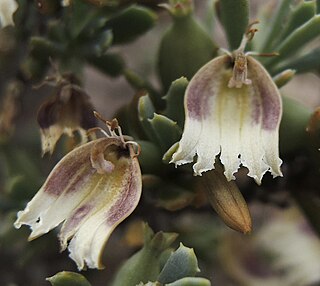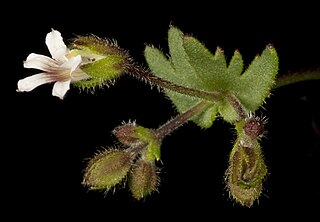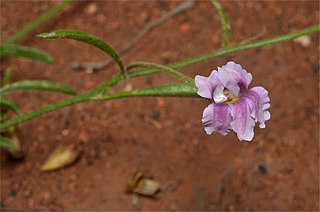
Scaevola collaris is a shrub in the family Goodeniaceae and its native range is five mainland states/territories of Australia: the Northern Territory, New South Wales, South Australia, Queensland and Western Australia.

Goodenia amplexans, commonly known as clasping goodenia, is a species of flowering plant in the family Goodeniaceae and endemic to South Australia. It is a small shrub with sticky foliage, egg-shaped to oblong or elliptic, stem-clasping leaves with small teeth on the edges, racemes of yellow flowers with leaf-like bracteoles at the base, and elliptic fruit.

Goodenia azurea, commonly known as blue goodenia, is a species of flowering plant in the family Goodeniaceae and is endemic to northern Australia. It is an erect, dense, spreading or sprawling, glaucous, perennial herb with egg-shaped leaves with the narrower end towards the base, racemes or thyrses of bluish-purple flowers with leaf-like bracts, and oval to cylindrical fruit.

Goodenia calcarata, commonly known as streaked goodenia, is a species of flowering plant in the family Goodeniaceae and is endemic to Australia. It is an erect, annual herb with toothed egg-shaped to oblong leaves, racemes of white, cream-coloured or pink to mauve flowers with brownish markings, and oval fruit.
Goodenia centralis is a species of flowering plant in the family Goodeniaceae and is endemic to central Australia. It is a prostrate, annual herb with coarsely toothed, spatula-shaped to egg-shaped leaves with the narrower end towards the base, and racemes of yellow flowers with purple veins.
Goodenia cusackiana is a species of flowering plant in the family Goodeniaceae and is endemic to the north-west of Western Australia. It an erect herb, densely covered with silvery hairs and has a woody stem, narrow elliptic to lance-shaped leaves, and racemes of yellow flowers.

Goodenia cycnopotamica is a plant in the Goodeniaceae family which is endemic to Australia, and found in both South Australia and Western Australia
Goodenia glauca, commonly known as pale goodenia, is a species of flowering plant in the family Goodeniaceae and is endemic to the drier inland areas of eastern continental Australia. It is a glaucous, erect, ascending perennial herb with lance-shaped to elliptic leaves and racemes of pale yellow flowers.
Goodenia halophila is a species of flowering plant in the family Goodeniaceae and is endemic to the northern Australia. It is a delicate annual herb with spatula-shaped, or lance-shaped leaves in a tuft at the base of erect or low-lying flowering stems, and cymes of yellow flowers.

Goodenia heterochila, commonly known as serrated goodenia, is a species of flowering plant in the family Goodeniaceae and is endemic to arid areas of Australia. It is an erect or ascending perennial herb with lance-shaped to egg-shaped stem leaves with the narrow end towards the base, and racemes of yellow flowers with a brownish centre.

Goodenia heteromera, commonly known as spreading goodenia or fan flower, is a species of flowering plant in the family Goodeniaceae and is endemic to south-eastern Australia. It is a perennial or annual, stolon-forming herb with lance-shaped to egg-shaped leaves with the narrow end towards the base, and racemes of yellow flowers with brownish markings.
Goodenia macroplectra is a species of flowering plant in the family Goodeniaceae and is endemic to inland Western Australia. It an erect herb with toothed, lance-shaped leaves at the base of the plant, and racemes of dark yellow flowers with a long spur.
Goodenia malvina is a species of flowering plant in the family Goodeniaceae and is endemic to north-western Australia. It is a prostrate to low-lying herb with egg-shaped to lance-shaped leaves on the stems and racemes of mauve to pinkish and yellowish flowers.
Goodenia muelleriana is a species of flowering plant in the family Goodeniaceae and is endemic to the north-west of Western Australia. It is an ascending to erect herb with elliptic to lance-shaped leaves at the base of the plant, and racemes of yellow flowers.

Goodenia pusilliflora, commonly known as small-flower goodenia, is a species of flowering plant in the family Goodeniaceae and is endemic to drier parts of southern Australia. It is a low-lying to ascending herb with oblong to egg-shaped leaves with toothed or lyrate edges, and racemes of small yellow flowers.
Goodenia quasilibera is a species of flowering plant in the family Goodeniaceae and is native to Western Australia and South Australia. It is an ascending to erect herb with lance-shaped leaves at the base of the plant, sometimes with toothed edges and racemes of yellow flowers with brownish lines.
Goodenia salmoniana is a species of flowering plant in the family Goodeniaceae and only known from the type specimen collected in Western Australia in 1889. It an erect to ascending herb, with linear leaves and racemes of dark yellow flowers.

Goodenia triodiophila, commonly known as spinifex goodenia in the Northern Territory, is a species of flowering plant in the family Goodeniaceae and is endemic to arid inland areas of Central Australia. It is a stiff, wiry, much-branched, ascending perennial herb with needle-shaped or linear leaves on the stems and racemes of yellow flowers with a brownish centre.

Goodenia vilmoriniae is a species of flowering plant in the family Goodeniaceae and is endemic to arid areas of Central Australia. It is an ascending to erect annual herb with linear to lance-shaped leaves at the base of the plant, and racemes of pale blue to lilac flowers.

Goodenia arguta, commonly known as spur velleia, or grassland goodenia, is a species of flowering plant in the family Goodeniaceae and endemic to continental Australia. It is a glabrous perennial with a rosette of leaves at the base of the plant and ascending flowering stems with deep yellow flowers.













